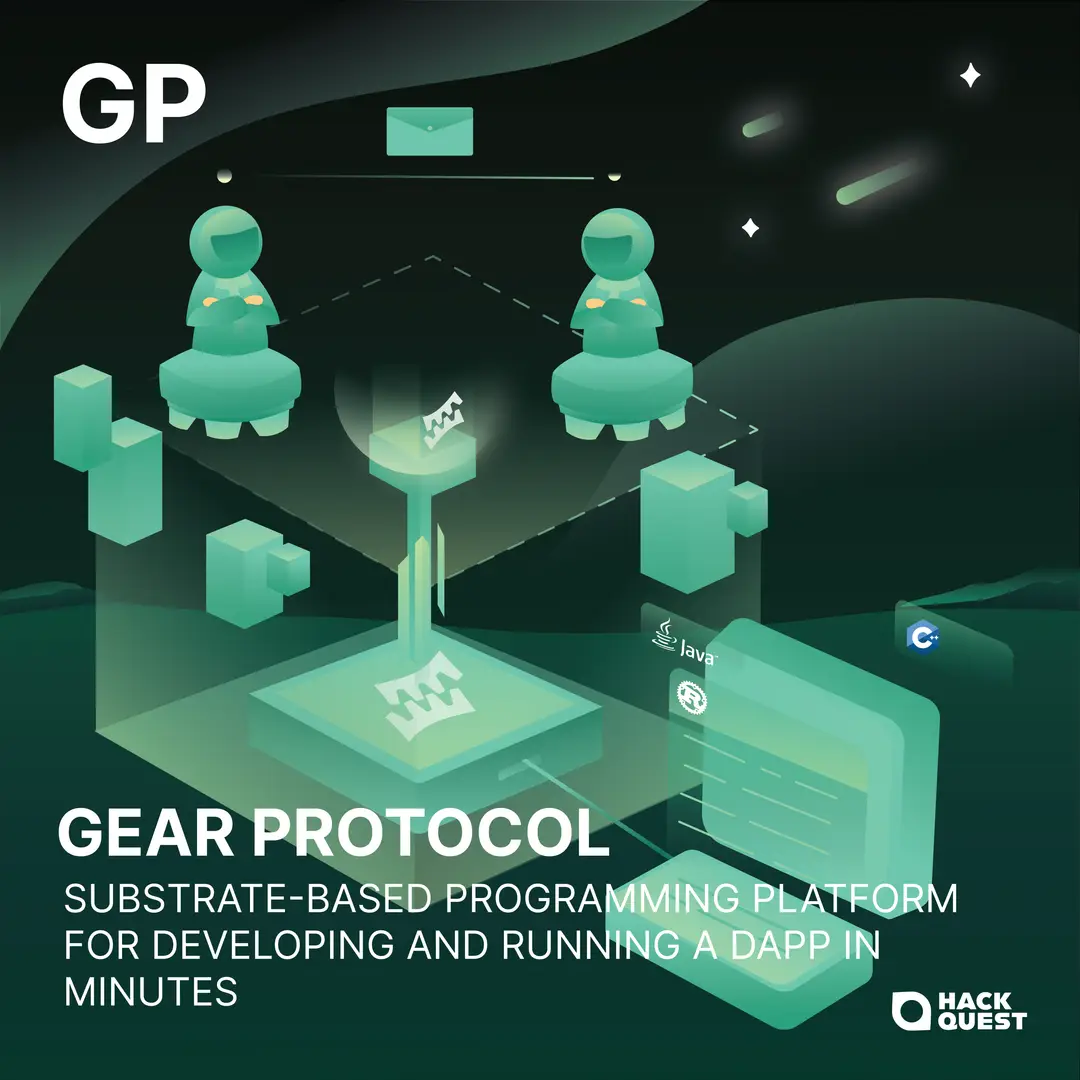Back
Gear Protocol
Vara Network
By HackQuest
Jul 9,20243 min readWelcome to the Web3 world, where digital finance and applications are shown in a revolutionary way through the fusion of blockchain technology, cryptocurrencies, and a pioneering spirit. Are you overwhelmed by the wealth of terms in the Web3 world that you don’t understand? Are those slangs barriers for you to learn about Web3? Don’t worry! We’re here to explain the obscure terms to guide your learning. Today, we're diving into an innovative development in the world of Web3: [Gear Protocol].

Definition and Overview
Gear Protocol is a cutting-edge Substrate-based WebAssembly smart contract platform that streamlines the shift from Web2 to Web3 development. It provides a smooth experience for deploying smart contracts without the need to develop a completely new blockchain and users can enjoy the benefits of blockchain technology and create dApps with ease and efficiency.
Technical Composition
The Gear Protocol technology is founded on three core pillars:
●In the Actor Model of communication, both programs and users are referred to as "actors." These actors keep their state private and interact through message exchanges, bolstering network security. All communications are asynchronous but logically ensured to be processed, which enhances network speed and facilitates the development of more complex dApps.
●Persistent Memory means that programs do not depend on shared storage; instead, they continuously store their entire state within their own memory spaces. Advanced and efficient memory virtualization techniques track memory access, ensuring that only necessary pages are saved and loaded as needed. This approach simplifies the development process by eliminating many complexities and making the mapping of running programs and their states more closely resemble real-life operating system primitives.
●WebAssembly enables the execution of any bytecode within a sandboxed environment. In Vara, smart contracts operate as Wasm programs (Actors). Because Wasm can be compiled from various popular programming languages, it significantly reduces the entry barrier for developers transitioning from the Web2 space. By providing native speed for deterministic cross-platform computations, Wasm unlocks the potential for Web3 development.
Core Functions
1.Decentralized Execution: Unlike many platforms that require external triggers for smart contracts, Gear's asynchronous messaging allows contracts to send delayed messages. This fosters more complex applications, true decentralization, and greater user value.
2.Messaging Automation: All Gear messages use gas. With its gas reservation system, if a program's gas is depleted, it can tap into reserved gas. Contracts can also schedule messages for future actions, similar to traditional cron jobs, enabling multiple autonomous on-chain operations as long as gas is available.
3.Payless Transactions: Gear introduces vouchers to enhance the user experience. These vouchers, issued by network entities, allow users to send messages to specific programs without incurring gas fees. This approach mirrors traditional web services, boosts user engagement, and simplifies application adoption, making the decentralized space more accessible and user-friendly.
Use Cases
Decentralized Lending and Borrowing
Description: Gear Protocol allows users to lend their assets to earn interest or borrow against their holdings, providing a decentralized alternative to traditional financial services.
Examples: A user can deposit ETH into the protocol and earn interest, or use their ETH as collateral to borrow USDC.
Advantages: Offers higher transparency and lower fees compared to traditional financial institutions. Enhances access to financial services globally.
Advantages: Eliminates the need for centralized exchanges, reducing the risk of hacks and providing greater privacy and security.
Description: Gear Protocol facilitates the creation and operation of DAOs by implementing and enforcing governance rules automatically, ensuring transparency and fairness.
Examples: A DAO can manage proposal submissions, voting processes, and result tabulation through asynchronous messaging and smart contracts.
Advantages: Ensures transparent governance, automates decision-making processes, and distributes trust across the network.
Identity and Access Management
Description: Gear Protocol supports decentralized identity solutions, allowing users to control their personal information and access rights securely.
Examples: Users can manage their digital identities and access various services without intermediaries.
Advantages: Provides secure identity management, enhances user privacy, and ensures controlled access to information.

Source: Gear-tech.io
Importance in Web3 Ecosystem
Gear Protocol's innovative architecture simplifies the creation and deployment of smart contracts, enabling developers to offer a wide range of new features and functionality in their dApps without needing to learn domain-specific languages (DSLs). Utilizing WebAssembly (WASM), Gear allows traditional businesses and Web2 developers to create dApps using familiar languages, running at native speeds for lower transaction costs and higher efficiency. The use of the Actor communication model enables parallel computing, providing unprecedented scalability. Gear addresses the limitations of contemporary smart contract platforms, which are constrained by shared global state and single-threaded processing, by natively supporting asynchronous messaging and parallel processing within smart contracts. This enhances composability, allowing the development of complex, fast, and secure dApps that implement features not possible with standard platforms.
User Experience and Innovations
Gear Protocol focuses on delivering a seamless user experience through intuitive interfaces and robust security measures. Innovations such as integrating decentralized oracles for accurate data feeds and optimizing smart contract performance ensure that users can interact with the protocol easily and securely.
Challenges
Despite its advantages, Gear Protocol faces challenges such as ensuring the security and reliability of its smart contracts, maintaining decentralization while scaling, and achieving widespread adoption. Continuous development and rigorous testing are essential to address these challenges and ensure the protocol’s long-term success.
Conclusion
Gear Protocol represents a significant advancement in the Web3 ecosystem by simplifying the development and deployment of smart contracts. Its use of WebAssembly (WASM) allows developers from traditional Web2 backgrounds to create decentralized applications (dApps) using familiar programming languages, thereby lowering the entry barrier. The innovative architecture of Gear Protocol, which includes the Actor Model for communication, Persistent Memory, and asynchronous messaging, ensures high scalability, security, and efficiency. These features enable the development of sophisticated, feature-rich dApps that offer enhanced user experiences. While Gear Protocol faces challenges related to security, decentralization, and adoption, its continuous evolution and robust framework position it as a promising platform for driving the next generation of Web3 applications. By addressing these challenges through ongoing development and innovation, Gear Protocol is poised to play a crucial role in the future of decentralized technology.
If you would like to learn more about terms like Yield Farming, let’s explore more in our HackQuest Web3 Glossary!
Join the HackQuest Community
[Twitter](https://twitter.com/HackQuest_)
[Telegram](https://t.me/hackquester)
[Discord](https://discord.gg/hWd9M8mCQh)
#Cyrpto Slang Terms #Web 3.0 Glossary #Token #Web 3.0 Words